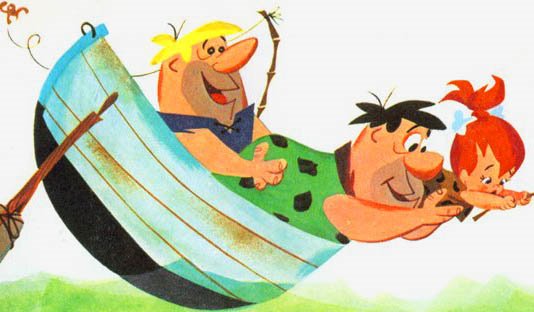
This is a real typical
McKimson attitude and expression. Pure sarcasm and disdain for your fellow creatures. Most of
McKimson's acting is done with gestures, motion and posing, not a lot of facial expressions.
McKimson's most specific expression is this sneer. You can see it in his scenes in
Clampett's cartoons too, only on cuter character designs.

The face is basically symmetrical except for the mouth - a frown that is tilted up and to one side.

This attitude pretty much sums up
McKimson's whole world view. His cartoons are built around a bunch of hard bitten abused souls who are looking to take their own turns at abusing other hapless creatures.
McKimson's world is literally a dog -eat -duck place, pretty much like the real world before hippies made us lie about ourselves. This is a total refreshing departure from the naive Disney world view that dominated cartoons in the mid to late 30s.

Even Porky is a hard-bitten middle aged jaded soul who has seen the true ugliness of the real world and knows there is only one way to survive.


Daffy Duck Hunt is a funny cartoon, but not quite as slick as "The Foghorn Leghorn". I have noticed 2 basic styles of
McKimson cartoons in the 40s. One very well drawn and fluidly animated, the other stiffer and with a less appealing drawing style.

I'm not sure why that is. Maybe he had an assistant who did layouts on the cartoons that were more stock stories? I've noticed this about Chuck Jones' cartoons too. Maybe they just drew some of them faster and used a more shorthand drawing and animation style so they could spend more time on the more innovative or special cartoons. Who knows?

Anyway, I love this verbal gag. It's pretty shocking actually to hear it in a cartoon.

I think this was written by Warren Foster. I wonder how he and
McKimson worked together. Foster wrote for
Clampett,
McKimson and
Freleng and was considered the funniest
storyman at Warner's. You can tell he had to adapt his own humor to the world views of his directors. He and
McKimson created a sort of simplified caricature of Tex Avery's
WB cartoons. They focused in on one element of Tex' work - his man-on-the-street attitude, added more acting and avoided the abstract pure
cartoony stuff.

This stuff kills me. It's a celebration of how ignorant and base we humans really are. It boils it down to our essence.
 http://www.cartoonthrills.org/blog/McKimson/47/DaffyDuckHunt/tortureme.mov
http://www.cartoonthrills.org/blog/McKimson/47/DaffyDuckHunt/tortureme.mov



 http://johnkstuff.blogspot.com/2008/05/were-you-at-toy-show-sunday.html
http://johnkstuff.blogspot.com/2008/05/were-you-at-toy-show-sunday.html


![[sody_george_jimmy.jpg]](https://blogger.googleusercontent.com/img/b/R29vZ2xl/AVvXsEjzNZJ2m4nNOWA2Wz7fYVaJf3tm_WAfJ6OUw8_mz09gLHmi5tYaPlt6T4GYVsF1FPOy-8KmnCys_VicELKCI1hQH4e5LN2O29qNMAZyvk6Gde59ZXm56V3Nwr8E0m53uBRjRi4p/s1600/sody_george_jimmy.jpg)















































